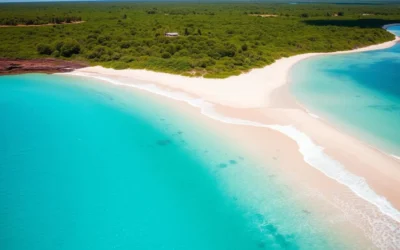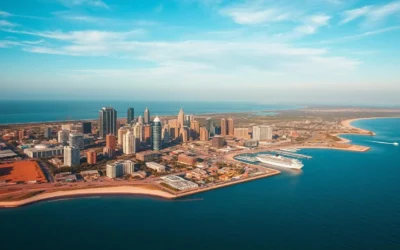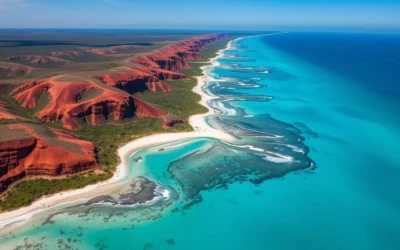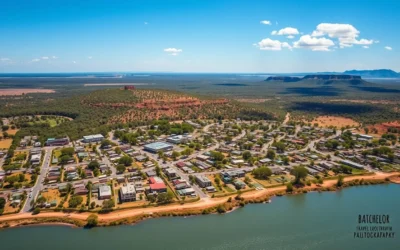Getting to Yulara
Yulara is a purpose-built resort town located just outside Uluru-Kata Tjuta National Park in Australia’s Red Centre. Despite its remote location, there are several ways to reach this magnificent destination.
By Air
The most convenient way to reach Yulara is by flying into Ayers Rock Airport (Connellan Airport), which receives direct flights from major Australian cities including Sydney, Melbourne, Brisbane, and Alice Springs. The airport is just a 10-minute drive from Yulara township.
By Road
If you prefer a road trip adventure, Yulara is approximately 450km (5 hours) southwest of Alice Springs via the Stuart and Lasseter Highways. The drive offers spectacular desert scenery, with Mount Conner (often mistaken for Uluru and nicknamed “Fooluru”) visible along the way.
The scenic drive to Uluru-Kata Tjuta National Park offers breathtaking views of the Red Centre
By Tour
Many visitors opt for organized tours departing from Alice Springs. These range from single-day excursions to multi-day adventures that include transportation, guided experiences, and sometimes accommodation. This option is ideal if you prefer not to drive yourself through the remote outback.
Best Time to Visit Yulara
The climate in Australia’s Red Centre is characterized by extreme temperature variations, so timing your visit is crucial for comfort and enjoyment.
| Season | Months | Temperature | Advantages | Considerations |
| Winter | June – August | 20°C (day), 0-5°C (night) | Perfect daytime temperatures for hiking, clear skies | Very cold nights, peak tourist season |
| Spring | September – November | 28-34°C (day), 12-16°C (night) | Wildflowers, fewer crowds than winter | Warming temperatures, occasional dust storms |
| Summer | December – February | 35-45°C (day), 20-25°C (night) | Fewer tourists, potential for dramatic storms | Extreme heat, limited hiking hours |
| Autumn | March – May | 25-32°C (day), 10-15°C (night) | Moderate temperatures, less crowded | Unpredictable weather patterns |
Local Tip: May to September (the Australian winter) offers the most comfortable temperatures for outdoor activities. If visiting during summer (December-February), plan outdoor activities for early morning or late afternoon to avoid the extreme midday heat.
Essential Uluru Experiences
Uluru (Ayers Rock) is the main attraction that draws visitors to Yulara. This sacred monolith offers several must-do experiences that showcase its natural beauty and cultural significance.
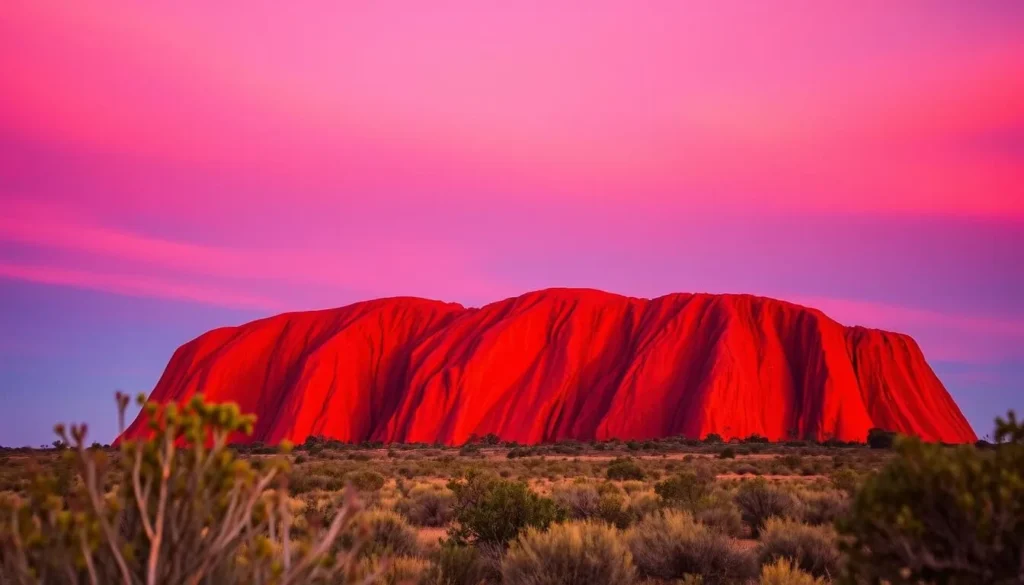
Uluru’s famous color transformation at sunset is a must-see spectacle
Uluru Base Walk
The 10.6km loop around the base of Uluru is one of the best ways to appreciate the scale and diversity of this natural wonder. The relatively flat path takes you past ancient rock art, waterholes, and unique geological formations. Along the way, you’ll find interpretive signs explaining the cultural significance of different sites to the Anangu people.
Walking Tips: Start early in the morning to avoid the heat. The complete circuit takes about 3-4 hours at a leisurely pace. Carry at least 1 liter of water per person per hour of walking, wear sun protection, and sturdy footwear.
Uluru Sunrise and Sunset Viewing
Witnessing Uluru change colors as the sun rises or sets is a magical experience. The rock transforms from deep purple to bright orange and fiery red, creating a spectacular natural light show. The national park has designated viewing areas with parking facilities for both sunrise and sunset.
Mutitjulu Waterhole Walk
This easy 1km return walk takes you to one of Uluru’s sacred waterholes. The path follows the natural contours of the rock and passes ancient rock art sites. The waterhole is often filled after rain, creating a peaceful oasis in the desert landscape. This is also where you can learn about the Kuniya (python woman) and Liru (poisonous snake man) creation stories.
Exploring Kata Tjuta (The Olgas)
Just 40km west of Uluru lies Kata Tjuta (formerly known as The Olgas), a collection of 36 dome-shaped rock formations that are equally impressive but often less crowded than their famous neighbor. The name Kata Tjuta means “many heads” in the local Pitjantjatjara language.
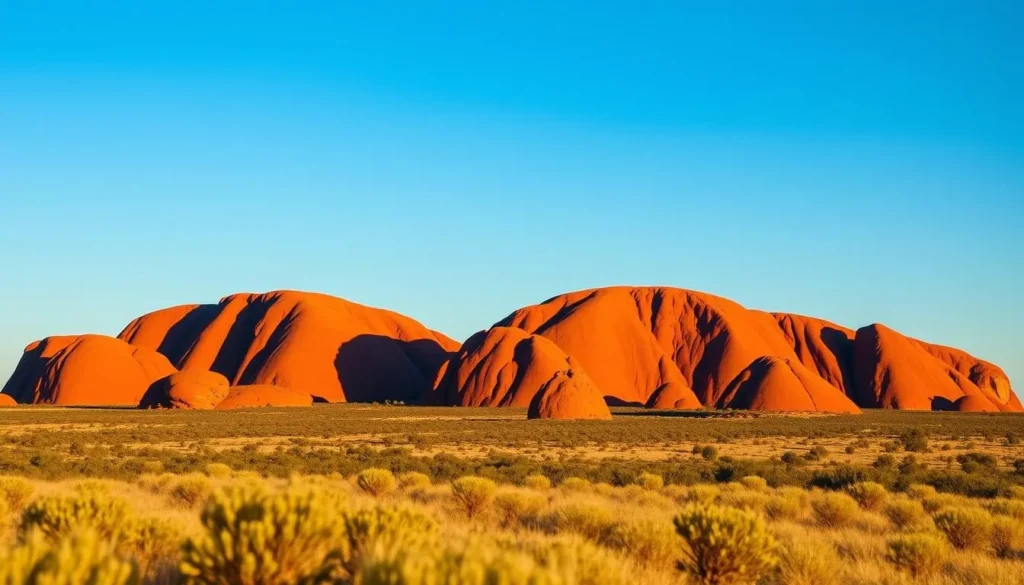
The magnificent domes of Kata Tjuta are equally impressive as Uluru
Valley of the Winds Walk
This challenging but rewarding 7.4km circuit takes you between the massive domes of Kata Tjuta. The trail features two spectacular lookout points – Karu Lookout (1.1km from the start) and Karingana Lookout (2.7km). The full circuit offers breathtaking views of the desert landscape and the unique geology of the domes.
Important: The Valley of the Winds walk may be partially or completely closed when temperatures are forecast to exceed 36°C (usually after 11am in summer). Check with the Cultural Centre before setting out.
Walpa Gorge Walk
For a less strenuous option, the 2.6km return Walpa Gorge walk takes you between two of the tallest domes of Kata Tjuta. The path follows a natural creek bed into a desert refuge for plants and animals. The towering walls create a wind tunnel (walpa means “wind” in the local language), providing natural air conditioning on hot days.
Cultural Experiences
The Uluru-Kata Tjuta region is the traditional homeland of the Anangu people, who have lived here for thousands of years. Understanding their deep connection to this land will enrich your visit immeasurably.

Learn traditional Aboriginal art techniques in a dot painting workshop
Uluru-Kata Tjuta Cultural Centre
Located within the national park, this center is the perfect starting point for understanding the cultural significance of Uluru and Kata Tjuta. Interactive displays explain Tjukurpa (the Anangu law, religion, and moral system), traditional tools, and the relationship between the Anangu and their land. The center also houses two art galleries where you can purchase authentic Aboriginal artwork.
Maruku Arts Dot Painting Workshop
Join local Anangu artists for a hands-on introduction to traditional dot painting. In this 90-minute workshop, you’ll learn about the symbols used in Aboriginal art and create your own painting to take home. The workshop provides a deeper understanding of how art is used to pass down knowledge and stories in Aboriginal culture.
Free Cultural Activities at Ayers Rock Resort
The Ayers Rock Resort in Yulara offers several free daily cultural activities, including:
- Bush Food Experience – Learn about traditional native foods
- Bush Yarn – Listen to stories about Aboriginal history and culture
- Guided Garden Walks – Discover how plants are used for food and medicine
- Didgeridoo Performances – Experience the unique sounds of this ancient instrument
- Aboriginal Dance Performances – Watch traditional dances that tell important stories
Unique Experiences in Yulara
Beyond the iconic rock formations, Yulara offers several unique experiences that will make your visit truly memorable.
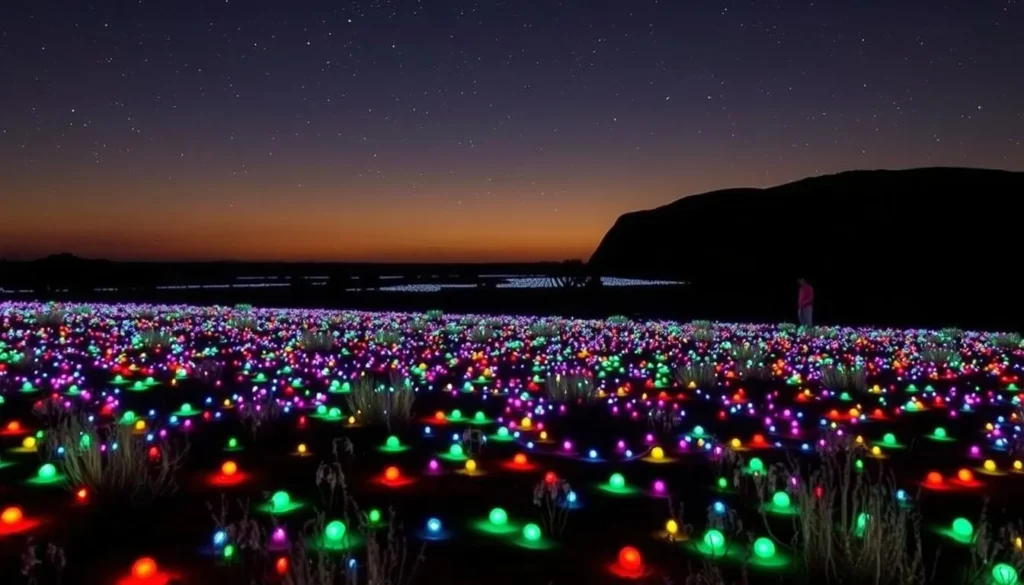
Bruce Munro’s Field of Light installation creates a magical landscape at night
Field of Light
This internationally acclaimed art installation by Bruce Munro features more than 50,000 slender stems crowned with frosted-glass spheres that bloom as darkness falls. The lights slowly change colors, creating a magical field of illumination beneath the desert night sky with Uluru as the backdrop. This ethereal experience has been so popular that it has been extended indefinitely.
Sounds of Silence Dinner
This award-winning dining experience begins with canapés and sparkling wine as you watch the sun set over Uluru and Kata Tjuta. As darkness falls, you’ll enjoy a gourmet buffet dinner featuring native ingredients under the starry desert sky. After dinner, an astronomer will guide you through the spectacular southern night sky.
Camel Tours
Experience the desert landscape the way early explorers did – on camelback. Camel tours operate at sunrise and sunset, offering a unique perspective of Uluru and Kata Tjuta. The gentle sway of the camel combined with the changing colors of the landscape creates an unforgettable experience.
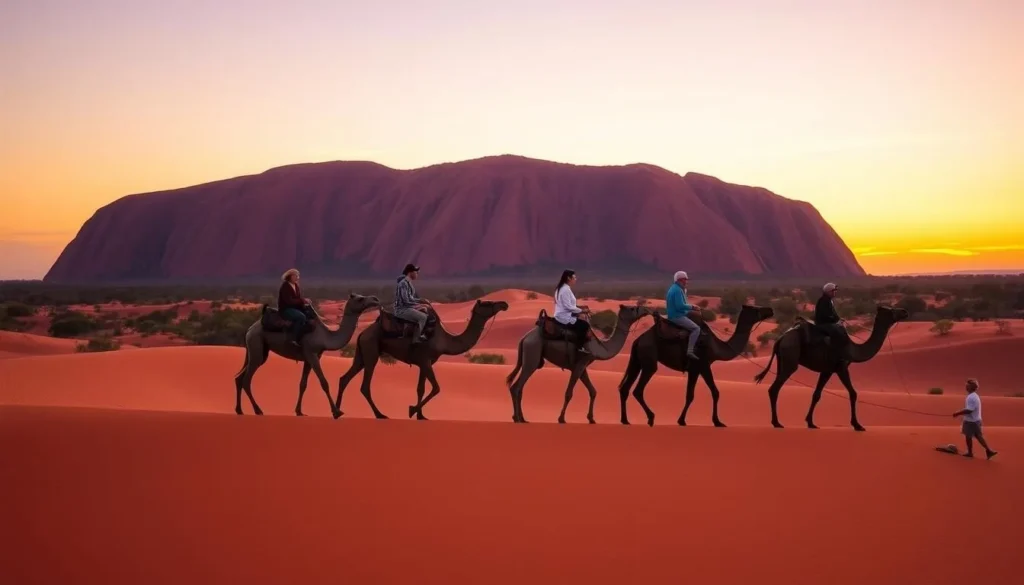
Camel tours offer a unique perspective of the desert landscape
Helicopter Flights
For a truly spectacular view of Uluru and Kata Tjuta, take to the skies in a helicopter tour. These flights offer a perspective that few get to experience, revealing the true scale and majesty of these ancient formations. Various flight durations are available, from quick 15-minute scenic flights to extended tours covering the entire region.
Where to Stay in Yulara
All accommodation in Yulara is managed by Ayers Rock Resort, which offers options ranging from luxury hotels to camping grounds. Each property provides different experiences while sharing access to the Town Square’s restaurants, shops, and free activities.
Luxury Options
- Sails in the Desert – 5-star hotel with spacious guestrooms, premium amenities, and the resort’s main pool
- Desert Gardens Hotel – 4.5-star hotel with rooms offering views of Uluru
- Longitude 131° – Ultra-luxury wilderness camp with private tented pavilions and uninterrupted views of Uluru
Mid-Range Options
- Emu Walk Apartments – Self-contained apartments ideal for families and longer stays
- The Lost Camel – Boutique-style hotel with contemporary rooms and access to resort facilities
Budget Options
- Outback Pioneer Hotel & Lodge – Affordable hotel rooms and dormitory-style accommodation
- Ayers Rock Campground – Powered and unpowered sites for caravans, campervans, and tents
Dining in Yulara
Despite its remote location, Yulara offers a surprising variety of dining options, from casual cafés to fine dining restaurants featuring native Australian ingredients.
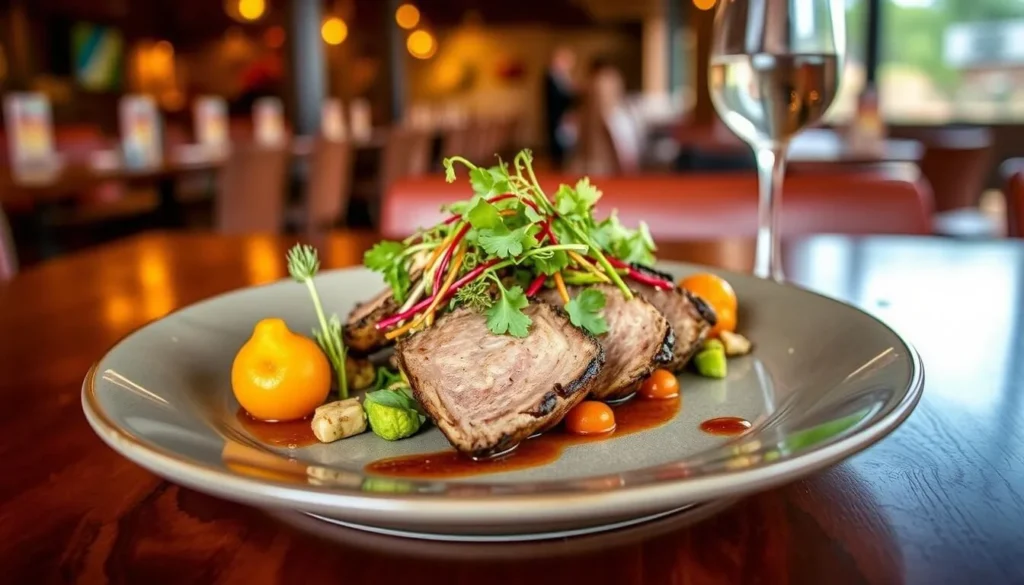
Many Yulara restaurants feature native Australian ingredients in their dishes
Top Dining Experiences
- Ilkari Restaurant – Buffet restaurant at Sails in the Desert featuring international cuisine and native Australian ingredients
- Walpa Lobby Bar – Casual dining with cocktails and tapas-style plates
- Arnguli Grill – Contemporary Australian cuisine focusing on native ingredients
- Outback Pioneer BBQ – Cook-your-own BBQ featuring kangaroo, emu, and crocodile meats
- Kulata Academy Café – Training café for indigenous hospitality students serving light meals and coffee
- Ayers Wok – Quick and casual Asian cuisine
Local Tip: Try the bush tucker-inspired dishes featuring ingredients like wattleseed, bush tomato, and desert lime. These native flavors have been used by Aboriginal people for thousands of years and offer a unique taste of Australia.
Practical Tips for Visiting Yulara
Preparation is key when visiting this remote desert location. Here are some essential tips to ensure a comfortable and enjoyable stay.
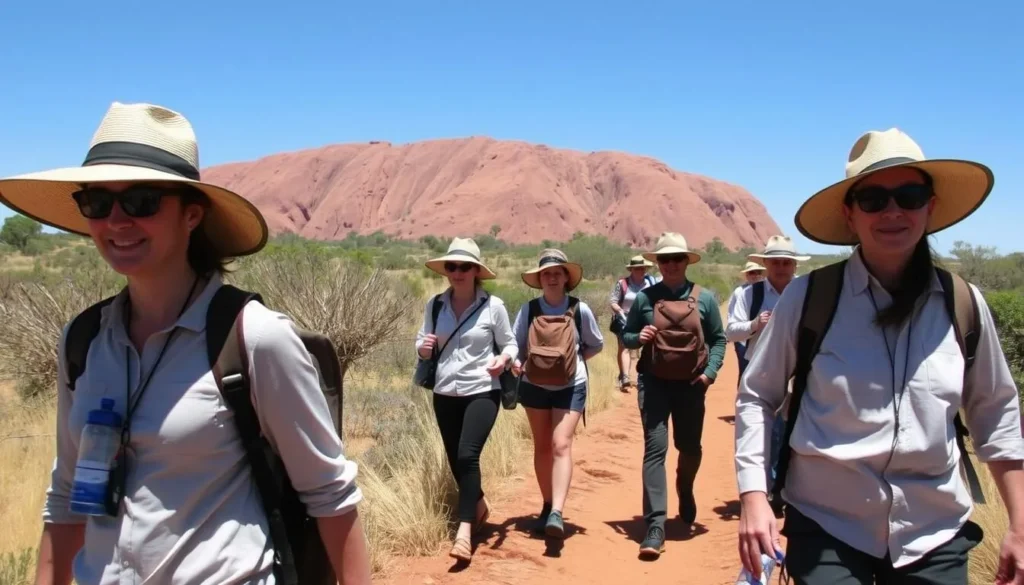
Proper clothing and plenty of water are essential when exploring the national park
National Park Entry
Entry to Uluru-Kata Tjuta National Park requires a pass, which costs $38 per adult for a 3-day visit (children under 18 enter free). Passes can be purchased online or at the entry station. The park has seasonal opening hours based on sunrise and sunset times.
Weather Considerations
The desert climate brings extreme temperature variations. Summer days (December-February) can exceed 40°C, while winter nights (June-August) can drop below freezing. Always check weather forecasts and plan activities accordingly.
What to Pack
- Wide-brimmed hat and sunglasses
- High SPF sunscreen
- Lightweight, long-sleeved clothing for sun protection
- Warm layers for cool mornings/evenings
- Comfortable walking shoes
- Reusable water bottle (at least 1L capacity)
- Insect repellent
- Camera with extra batteries
- Fly net (especially in summer months)
Respecting Cultural Sensitivities
Uluru and Kata Tjuta are sacred sites to the Anangu people. Visitors are asked to respect their cultural beliefs by not climbing Uluru (which has been officially closed to climbing since October 2019), staying on marked paths, and not photographing certain sensitive areas (which are clearly marked).
Important: Mobile coverage is generally good in Yulara and around Uluru, but can be patchy or non-existent in more remote areas. Download maps and information before venturing out, and always let someone know your plans if exploring independently.
Day Trips from Yulara
While Uluru and Kata Tjuta are the main attractions, there are several other remarkable places within day-trip distance of Yulara.
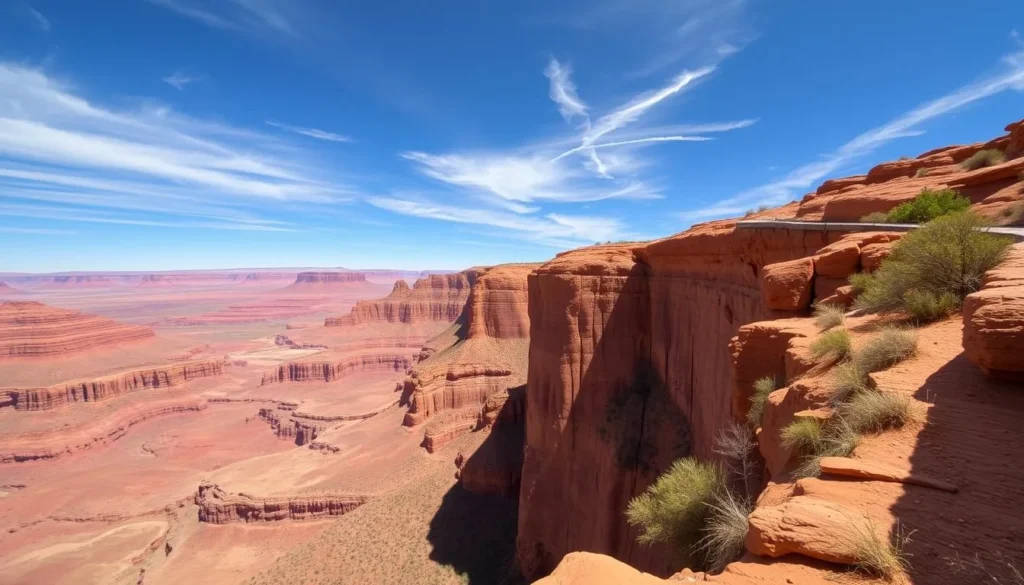
Kings Canyon offers spectacular views and challenging hiking trails
Kings Canyon
Located about 300km northeast of Yulara (a 4-hour drive), Kings Canyon in Watarrka National Park features spectacular 100m high sandstone walls, palm-filled crevices, and views across the desert. The 6km Rim Walk is challenging but rewarding, taking 3-4 hours to complete. Start early in the morning to avoid the heat, especially in summer when the walk may close after 9am due to extreme temperatures.
Mount Conner
Often mistaken for Uluru by first-time visitors (earning it the nickname “Fooluru”), Mount Conner is a horseshoe-shaped mesa located on private property about 100km east of Yulara. Tours to Mount Conner include a 4WD adventure across the red sand dunes and salt lakes, culminating in a visit to this impressive formation that’s actually 100 million years older than Uluru.
Suggested Itineraries
Not sure how to plan your time in Yulara? Here are some suggested itineraries based on the length of your stay.
2-Day Itinerary: Essential Uluru
Day 1
- Morning: Arrive in Yulara and check into accommodation
- Afternoon: Visit the Cultural Centre to learn about Anangu culture
- Evening: Watch sunset at Uluru followed by Field of Light experience
Day 2
- Early Morning: Uluru sunrise viewing
- Morning: Uluru Base Walk or Mala Walk (guided)
- Afternoon: Kata Tjuta sunset viewing
- Evening: Sounds of Silence dinner experience
4-Day Itinerary: Complete Red Centre
Day 1
- Morning: Arrive in Yulara and check into accommodation
- Afternoon: Cultural Centre and Mutitjulu Waterhole walk
- Evening: Uluru sunset viewing
Day 2
- Early Morning: Uluru sunrise viewing
- Morning: Uluru Base Walk
- Afternoon: Aboriginal dot painting workshop
- Evening: Field of Light experience
Day 3
- Early Morning: Kata Tjuta sunrise viewing
- Morning: Valley of the Winds Walk
- Afternoon: Relax at resort pool or join free cultural activities
- Evening: Sounds of Silence dinner
Day 4
- Full Day: Kings Canyon day trip (early start recommended)
- Evening: Stargazing experience
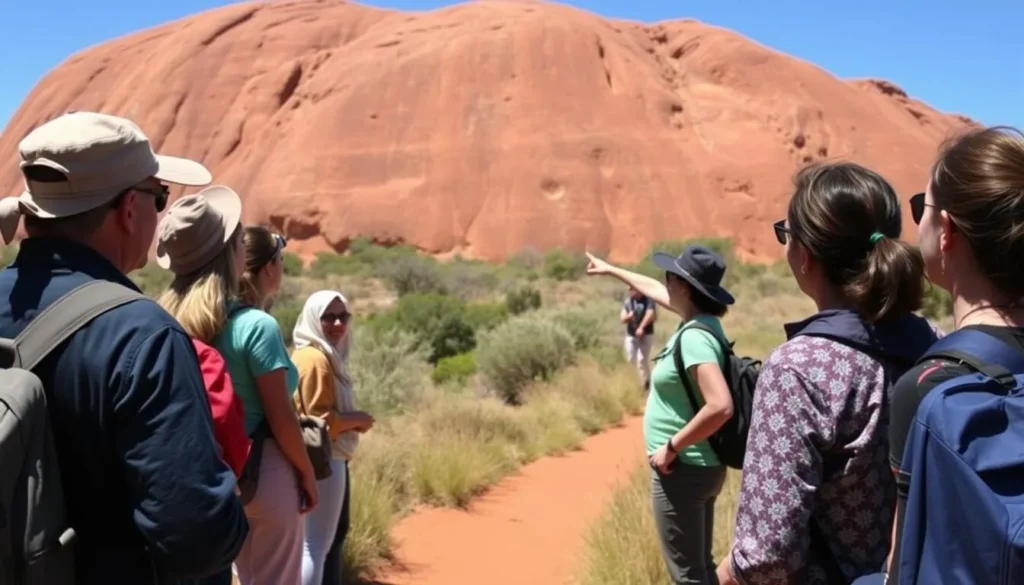
Guided walks with Aboriginal guides provide deeper insights into the cultural significance of Uluru
Family-Friendly Activities in Yulara
Traveling with children? Yulara offers plenty of activities that are suitable for families with kids of all ages.
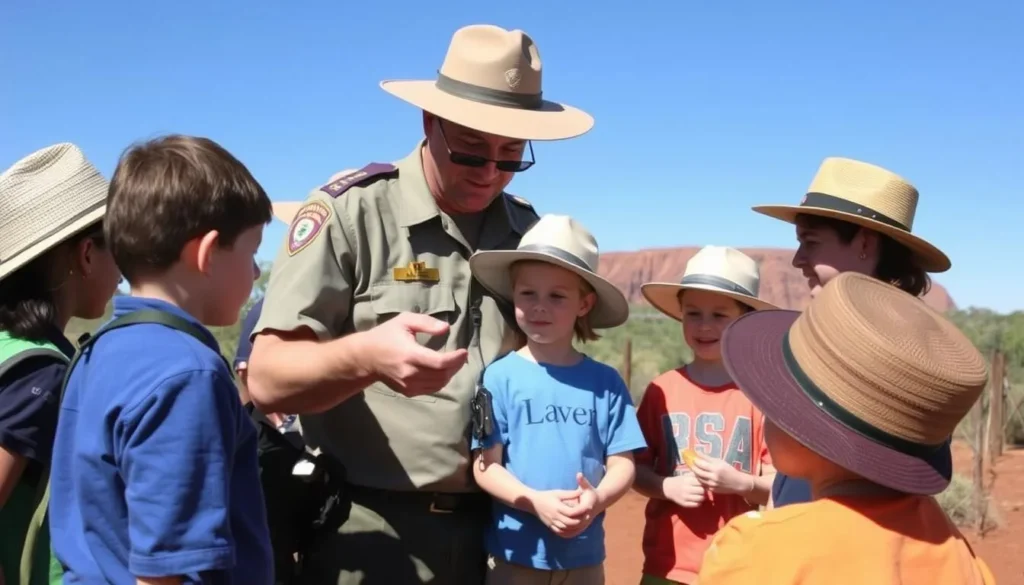
Ranger-guided activities are educational and fun for children of all ages
Kid-Friendly Experiences
- Junior Ranger Program – Children can collect a Junior Ranger activity booklet from the Cultural Centre and complete activities to learn about the park’s natural and cultural values
- Astronomy Sessions – Nightly stargazing sessions at the resort are fascinating for children and adults alike
- Bush Tucker Experiences – Interactive sessions where kids can learn about traditional foods
- Camel Rides – Shorter camel rides are available for families with younger children
- Resort Pool – The main pool at Ayers Rock Resort is perfect for cooling off after a day of exploration
Best Walks for Families
While the complete Uluru Base Walk might be too long for young children, there are several shorter walks that are perfect for families:
- Mala Walk – 2km return, partially guided, with rock art and cultural sites
- Kuniya Walk to Mutitjulu Waterhole – 1km return, easy walk to a permanent waterhole
- Walpa Gorge at Kata Tjuta – 2.6km return, relatively flat walk between towering domes
Family Tip: The free shuttle bus service around Ayers Rock Resort is a lifesaver when traveling with tired children. It runs continuously throughout the day, connecting all accommodation options with the Town Square.
Photography Tips for Yulara and Uluru
The Red Centre offers some of Australia’s most photogenic landscapes. Here are some tips to capture stunning images during your visit.
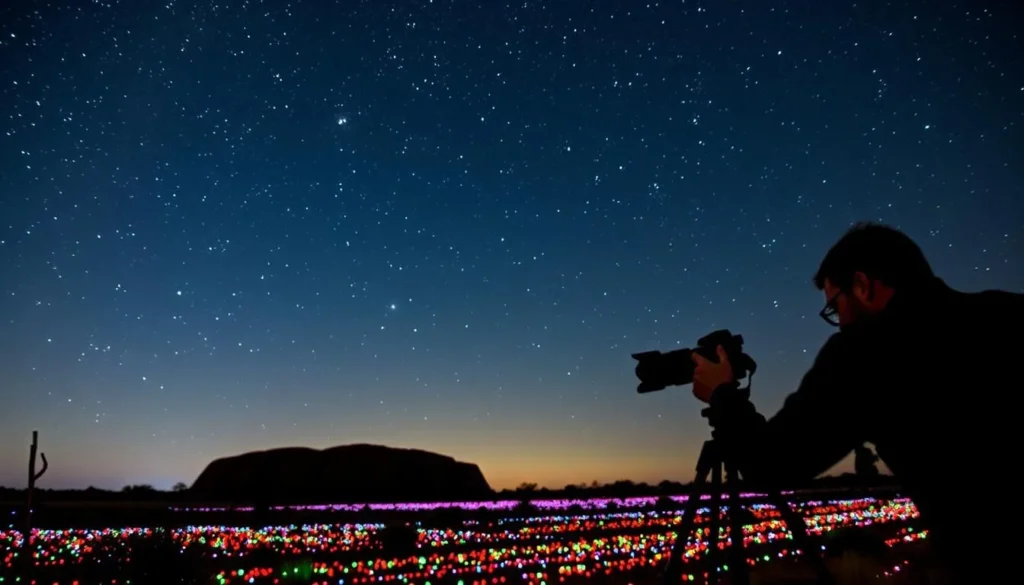
The combination of Field of Light, stars, and Uluru creates magical nighttime photography opportunities
Best Photography Locations
- Uluru Sunset Viewing Area – Classic views of the rock changing colors
- Kata Tjuta Dune Viewing Area – Panoramic views of both Uluru and Kata Tjuta
- Mutitjulu Waterhole – Reflections of Uluru in the water (when filled)
- Desert Oak Trees – Silhouettes against the orange sunset sky
- Field of Light – Magical night photography opportunity
Best Times for Photography
- Golden Hour – The hour after sunrise and before sunset offers the most dramatic lighting
- Blue Hour – Just before sunrise and after sunset for moody silhouettes
- Night – For astrophotography (the dark skies here are perfect for capturing the Milky Way)
Essential Photography Gear
- Tripod for low-light and night photography
- Polarizing filter to enhance the red colors and blue sky
- Wide-angle lens for landscape shots
- Telephoto lens for detail shots and wildlife
- Extra batteries (the heat can drain them quickly)
- Lens cleaning kit (the red dust gets everywhere)
Cultural Respect: Some areas around Uluru are sacred to the Anangu people and photography is prohibited. These areas are clearly marked with “No Photography” signs. Please respect these restrictions.
Budget-Friendly Tips for Yulara
Visiting the Red Centre can be expensive due to its remote location, but there are ways to experience this magical place without breaking the bank.
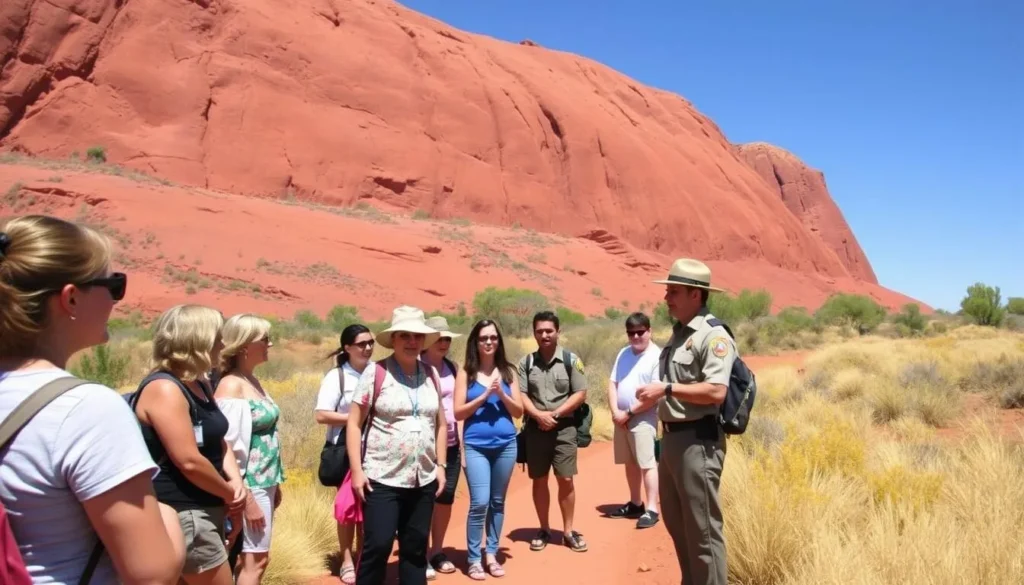
The free ranger-guided Mala Walk offers valuable cultural insights
Free Activities
- Ranger-guided Mala Walk – Free guided walk offered daily by park rangers
- Cultural Centre – No additional charge beyond park entry
- Sunrise and Sunset Viewing – Use the designated areas included with park entry
- Resort Activities – Ayers Rock Resort offers free daily activities including bush food experiences, guided garden walks, and cultural performances
- Stargazing – The night sky here is spectacular and completely free to enjoy
Money-Saving Tips
- BYO Food – The IGA supermarket in Yulara Town Square allows you to self-cater some meals
- Water Bottles – Bring reusable water bottles and refill them at drinking fountains
- Camping – Stay at the Ayers Rock Campground for the most economical accommodation
- Visit in Shoulder Season – May and September offer good weather with lower prices than peak season
- Package Deals – Look for packages that combine accommodation with activities
Budget Tip: The Outback Pioneer Hotel offers a DIY BBQ where you can purchase meat to cook yourself, which is more affordable than the resort restaurants.
Essential Packing List for Yulara
The remote desert location and extreme climate of Yulara require careful packing. Here’s what you shouldn’t leave home without:
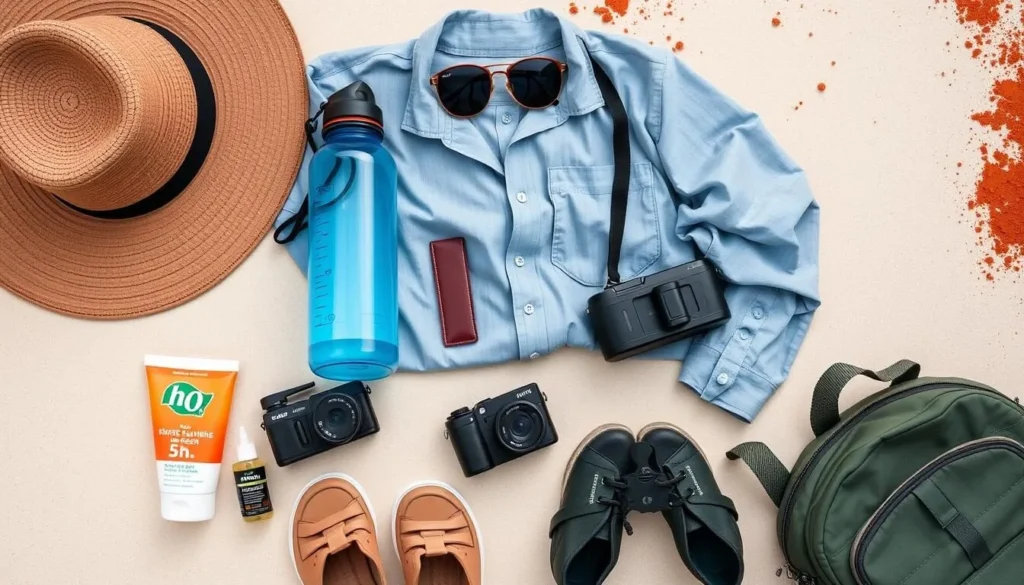
Pack these essentials for a comfortable and safe visit to the Red Centre
Clothing
- Lightweight, breathable clothing
- Long-sleeved shirts and pants (for sun protection)
- Warm layers for cool mornings/evenings
- Comfortable walking shoes
- Wide-brimmed hat
- Swimwear (for resort pools)
- Fly net (especially in summer)
Sun Protection
- High SPF sunscreen (50+)
- Lip balm with SPF
- Sunglasses
- After-sun lotion or aloe vera
- UPF-rated clothing if possible
Other Essentials
- Reusable water bottles
- Insect repellent
- Basic first aid kit
- Camera and extra batteries
- Binoculars for wildlife spotting
- Backpack for day hikes
- Portable phone charger
Packing Tip: Choose neutral or earth-toned clothing as the red dust can permanently stain light-colored fabrics. Avoid bringing white clothing items that you’re particularly fond of!
Plan Your Unforgettable Yulara Adventure
Yulara and the surrounding Uluru-Kata Tjuta National Park offer a truly unique Australian experience that combines natural wonders, ancient culture, and unforgettable desert landscapes. From watching Uluru change colors at sunset to learning about one of the world’s oldest living cultures, a visit to Australia’s Red Centre will leave you with memories to last a lifetime.
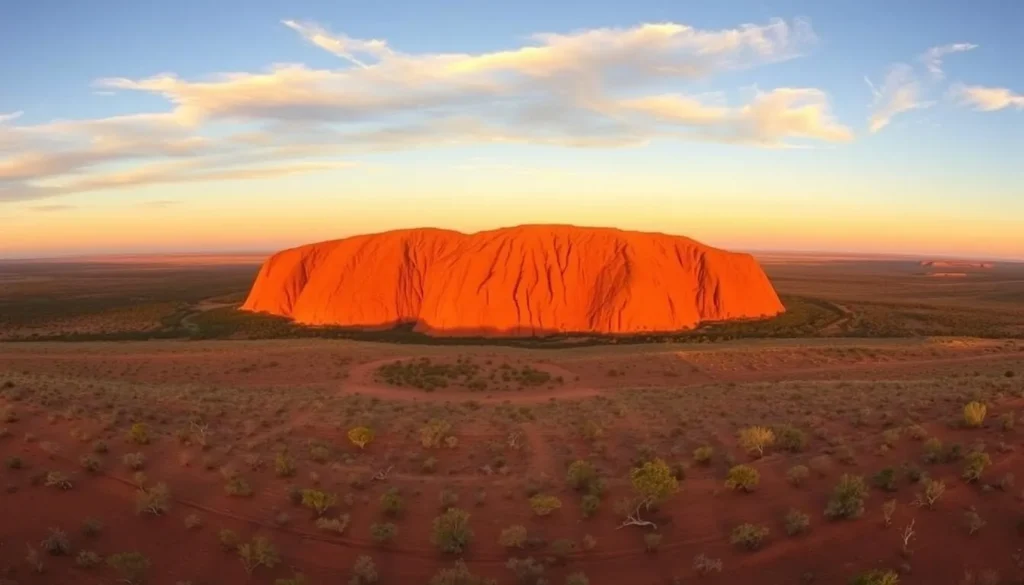
The timeless beauty of Uluru will leave you with memories to last a lifetime
Whether you’re seeking adventure, cultural enrichment, or simply the awe-inspiring experience of standing before one of the world’s most recognizable natural landmarks, Yulara provides the perfect base for exploring this spiritual heart of Australia. The combination of ancient landscapes, world-class facilities, and the profound cultural significance of this place creates an experience unlike any other on Earth.
Frequently Asked Questions
How many days do I need in Yulara?
A minimum of 2-3 days is recommended to experience the highlights of Uluru-Kata Tjuta National Park. This allows time for sunrise and sunset viewings, the Uluru Base Walk, and exploring Kata Tjuta. If you want to include Kings Canyon or participate in additional cultural activities, consider staying 4-5 days.
Can I climb Uluru?
No, climbing Uluru has been permanently closed since October 26, 2019, out of respect for the wishes of the traditional owners, the Anangu people, who consider the site sacred. There are many other respectful ways to experience Uluru, including the Base Walk, cultural tours, and viewing areas.
Is Yulara expensive?
Yes, due to its remote location, prices in Yulara are generally higher than in major Australian cities. This applies to accommodation, food, fuel, and activities. However, there are budget options available, including camping and self-catering, as well as many free activities offered by both the national park and Ayers Rock Resort.
What’s the difference between Uluru and Ayers Rock?
Uluru and Ayers Rock are two names for the same landmark. Uluru is the traditional Aboriginal name used by the Anangu people, while Ayers Rock was the name given by European explorers in the 1870s. The official name is now Uluru/Ayers Rock, with Uluru being the preferred name out of respect for the traditional owners.
Can I visit Uluru with children?
Absolutely! Uluru-Kata Tjuta National Park is family-friendly with several walks and activities suitable for children. The Cultural Centre, shorter walks like the Mala Walk and Mutitjulu Waterhole, and the free activities at Ayers Rock Resort are all great for kids. Just be sure to plan outdoor activities for cooler parts of the day and bring plenty of sun protection and water.
